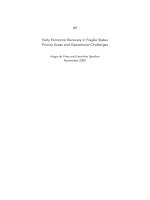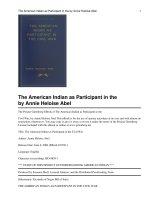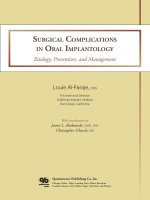Alpha fluorinated aromatic ketone as nucleophile in asymmetric organocatalytic c n and c c bonds formation reactions 4a
Bạn đang xem bản rút gọn của tài liệu. Xem và tải ngay bản đầy đủ của tài liệu tại đây (211.94 KB, 18 trang )
Chapter 4
69
Chapter 4
Enantioselective C-C
bond formation reactions of
catalyzed by chiral bicyclic guanidine
Enatioselective C-C bond formation
70
4.1 Introduction
Asymmetric C-C bond formation reactions are important reactions in organic
synthesis. Among the various asymmetric organic reaction, asymmetric Mannich
and Michael reactions are much more useful reactions for preparation of chiral
functionalized organic molecules. Recently, more efforts were donated to the
development of efficient chiral organocatalysts for pre-formed enolates and more
reactive methlenes,
1
but the highly enantioselective Mannich and Michael
reactions of aromatic ketones were still rarely reported.
N
HN
HN
F
3
C
CF
3
O
dr: 86/14-99/1
yield: 75-84%
ee:94-95%
O
R
1
R
2
CN
+
N
Boc
cat.
143
10 mol%
toluene, -78
o
C
O
R
1
CN
R
2
Ph
NHBoc
141
142
144
cat.
143
O
CN
n
R
O
CN
dr: 100/0
yield: 75-81%
ee:90->99%
141a
141b
O
CN
141c
dr: 59/41
yield: 80%
ee:98/98%
144a:
144b
144c:
Scheme 4.1 Asymmetric Mannich reaction of -cyano ketones.
Kim et al.
2
reported the asymmetric Mannich reaction between -cyano
ketones 141 and N-Boc-aldimines 142 in presence of chiral bifunctional
Chapter 4
71
organocatalyst 143. The desired Mannich products 144 were obtained with
excellent ee values and good yields. The best enantioselectivities were achieved
with cyclic aliphatic ketones 141a. Moreover, cyclic aromatic ketones 141b and
acyclic ketone 141c reacted with 142 to afford products with high ee values (up to
98% ee) (Scheme 4.1).
Deng et al.
3
reported the highly enantioselective and diastereoselective tandem
conjugate addition and protonation of -cyano ketones 145 and
-chloroacrylonitrile 146. The -cyano ketones 145 of different ring size were
tolerated under the reaction conditions in presence of organocatalyst QD-1 or
QD-2 (Scheme 4.2).
dr: 9/1-16/1
yield: 94-99%
ee:97-99%
cat.
QD-1
or
QD-2
(10 mol%)
toluene, RT
O
CN
n
n=0,1,2
Cl
CN
+
O
CN
n
Cl
CN
QD-1
HN
F
3
C CF
3
S
HN
N
OMe
N H
OR
4
N
H
N
OH
R
4
=
QD-2
dr: 8/1-25/1
yield: 87-95%
ee:91-96%
145
146
147
Scheme 4.2 Asymmetric conjugated addition reaction of -cyano ketones.
Zhao et al.
4
reported a Michael addition of -substituted cyano ketones to
-keto esters using bifunctional thiourea-tertiary amine catalyst 150. The
Enatioselective C-C bond formation
72
3-oxo-3-phenylpropanenitrile 148 reacted with -keto esters 149 to afford the
chiral dihydropyrans 151 with high enantioselectivities (up to 95% ee) (Scheme
4.3).
CN
O
O
CO
2
R
2
R
1
+
150
,2.0mol%
Et
2
O, RT
O
Ph
NC
R
1
CO
2
R
2
OH
148
149
151
yield: 70-95%
ee:87-95%
R
H
N
N
H
N
S
CF
3
CF
3
R=4-BnO-C
6
H
4
-CH
2
-
150
Scheme 4.3 Asymmetric Michael reaction of -substituted cyano ketones
This chapter will present the -fluorinated aromatic ketones in the asymmetric
Mannich and Michael reactions.
4.2 Asymmetric Mannich reaction of -fluorinated aromatic
ketones
4.2.1 Synthesis of imines and pentanidines; Pentanidines catalyzed
asymmetric Mannich reaction
The imines 154a-154k were prepared according the reported procedures.
5
Under neat conditions, they were easily obtained in presence of Si(OEt)
4
at
high
temperature as 160
o
C, and the crude products could be purified by
recrystallization over Hexane and EA (Scheme 4.4). The purified imines should
be kept in the -4
o
C fridge.
Chapter 4
73
R
2
S
O
O
NH
2
O
Si(OEt)
4
160
o
C
N
154a
:R
1
=H, R
2
=3,5-Me
2
C
6
H
4
154b
:R
1
= p-Cl, R
2
= p-CH
3
C
6
H
4
154c
:R
1
= p-Cl, R
2
=Me
154d
:R
1
= p-Cl, R
2
=2-napthyl
154e
:R
1
= p-Cl, R
2
=Bn
154f
:R
1
=H, R
2
= p-ClC
6
H
4
154g
:R
1
= p-CH
3
O, R
2
=Me
SO
2
R
2
R
1
R
1
152
153
154
yield: 50-90%
154h
:R
1
= o-CH
3
,R
2
=Me
154i
:R
1
= p-Br
,
R
2
=Me
154j
:R
1
= p-Br, R
2
=Et
154k
:R
1
= p-CH
3
O, R
2
=Bn
Scheme 4.4 Synthesis of imines 154
Ar Ar
H
2
N NH
2
HN NH
Ar Ar
S
EtOH/H
2
O
concd. HCl
NNH
Ar Ar
SMe
HI
155a:
Ar = Ph
156
CS
2
reflux
155b:
Ar = p-CH
3
OC
6
H
4
MeI
MeOH, 0
o
C
157
1. NH
3
(g)
MeOH
3days
HN NH
Ar Ar
NH
158
Ar Ar
H
2
N NH
2
RBr
K
2
CO
3
DMF, RT
Ar Ar
RHN NHR
triphosgene/Et
3
N
CH
2
Cl
2
NN
Ar Ar
R R
Cl
Cl
N
N
N
N
H
N
Ar
ArAr
Ar
R
R
HCl
imidazoline salt
Lawessen'
reagent
o-xylene
145
o
C
155a:
Ar = Ph
155b:
Ar = p-CH
3
OC
6
H
4
159
160
Ar Ar
RHN NR
O
Ar Ar
RN NR
S
2. NaOH(5 M)
THF, RT
(COCl)
2
toluene
80
o
C
161
162
158
4Å MS, MeCN
reflux
163
Cl
163a
:Ar=Ph,R=Bn
163b
:Ar=Ph,R=Me
163c
:Ar=p-CH
3
OPh, R = Bn
163d
:Ar=p-CH
3
OPh, R = 2-napthyl
N
N
N N
H
N
Ph
Ph
163e
Ph
Ph
Scheme 4.5 Synthesis of pentanidines (163a and 163e by Fu xiao; 163b by Dr
Chen jie).
The chiral pentanidines 163a-163d were prepared from commercial diamine
155 via multi-steps.
6
The thiourea 156 was easily prepared from the starting
material diamines with excellent yields, by treatment with MeI to afford
Enatioselective C-C bond formation
74
compound 157. Then, the guanidine intermediates 158 were obtained from 157
after treatment of 157 with ammonia gas in MeOH solution for three days and
basification with NaOH solution. The N-protected 159 were prepared from the
same starting material 155, followed by the reaction with triphosgene to give urea
160. Because of the poor reactivity of urea 160, they should be transformed into
thiourea 161 by Lawessen’s reagent. Then, the air and moisture sensitive
imidazoline salts 162 were prepared form thiourea 161. The pentanidine salts
were achieved by the reaction between 162 and 158, followed by basification with
K
2
CO
3
to give pure pentanidine catalysts 163a-163d. Pentanidine 163e was
prepared by Fuxiao by the modificated procedure of others (Scheme 4.5).
Table 4.1 Various pentanidines catalyzed asymmetric Mannich reaction
O
F
+
N
S
O
O
10 mol% Pentanidines
THF, RT
5-24 h
O
F
H
N
S
O
O
82d
154a
164a
Entry Pentanidines
Reaction
time/h
Product Convn/%
a
dr
b
ee/%
c
1 163a 8 164a 70 4/1 50/81
2 163b 15 164a 80 1/3 69/47
3 163c 15 164a 80 1/3 72/52
4 163d 24 164a 70 1/5.5 75/50
5 163e 5 164a 60 9/1 4/2
a
Monitored by TLC
b
Monitored by
1
H NMR;
c
Chiral HPLC analysis
The initial asymmetric Mannich reaction was carried out between -fluorinated
Chapter 4
75
aromatic ketone 82d and imine 154a with 10 mol% pentanidine 163a. The desired
product 164a was achieved with moderate enantioselectivity and
diastereoselectivity (Table 4.1, entry 1). Other pentanidines 163b-163d were also
effective for this asymmetric Mannich reaction, and similar results were obtained
under the same reaction conditions. The reaction did not show any
enantioselectivity in presence of pentanidine 163e although the best
diastereoselectivity 1/9 was obtained.
Table 4.2 Asymmetric Mannich reaction of various imines
Entry Imines
Reaction
time/h
Product Convn./%
a
dr
b
ee/%
c
1 154a 8 164a 70 4/1 50/81
2 154b 5 164b 100 1/4 78/56
3 154c 8 164c 100 1/2 3/52
4 154d 24 164d 60 1/1 20/78
5 154e 15 164e 80 1/4 73/58
6 154f 24 164f 60 1/4 68/49
a
Monitored by TLC
b
Monitored by
1
H NMR;
c
Chiral HPLC analysis
Different N-protected imines 154a-154f were examined in the asymmetric
reaction in the presence of 10 mol% pentanidine 163a at room temperature. The
imines 154b and 154c showed good reactivity with -fluorinated aromatic ketone
Enatioselective C-C bond formation
76
82d, but lower enantio- and diastereoselectivity of product 164c were obtained
due to lowered steric effect (Table 4.2 entry 3). The much bulky imine 154a and
154d reacted with 82d slowly and afforded one diastereomer with better
enantioselectivities (Table 4.2 entries 1 and 4).
4.2.2 Chiral bicyclic guanidine catalyzed asymmetric Mannich reaction
From the results of pentanidines catalyzed asymmetric Mannich reactions, the
enantioselectivities and diastereoselectivities were not excellent for all the cases.
Table 4.3 Asymmetric Mannich reaction of various imines
Entry Imines T/
o
C Product Convn./%
a
dr
b
ee/%
c
1 154b RT 164b 40 3.2/1 28/50
2 154c RT 164c 70 3/2 82/24
3 154g RT 164b 80 3/2 92/11
4 154h RT 164h 30 1/1 83/0
5 154i -20 164i 60 2/1 89/10
6 154j -20 164j 60 2/1 90/0
7 154k -10 164k 80 1.2/1 91/30
a
Monitored by TLC.
b
Monitored by
1
H NMR.
c
Chiral HPLC analysis.
We examined this reaction by using chiral bicyclic guanidine. And it was
Chapter 4
77
proven to be a good catalyst for the asymmetric Mannich reaction of -fluorinated
aromatic ketones. The effect of different protecting groups on imines was
investigated in the preliminary study. The reaction between aryl sulfonyl imine
154b and 82d was sluggish with 40% conversion and low enantioselectivity
(Table 4.3 entry 1). When the protecting group of imine was replaced by alkyl
sulfonyl group, all of the Mannich products (164c-164b, 164h-164k) showed
good ee values for one diastereoisomer although the diastereoselectivities were
moderate (Table 4.3, entries 2-7). Fortunately, the major diastereosiomers gave the
better ee values than their minor counterparts.
Table 4.4 Solvent and temperature effect on the asymmetric Mannich reaction of
-fluorinated aromatic ketone 82d
Entry Solvent T/
o
C Time/h Convn./%
a
dr
b
ee/%
c
1 THF RT 18 70 3/2 82/24
2 DCM RT 18 80 2/1 86/0
3 toluene RT 18 NR / /
4 TBME RT 18 70 2/1 78/27
5 DCE -10 66 >90 1.8/1 89/0
6 DCE -20 96 >90 3.0/1 96/5
a
Determined by TLC.
b
Determined by
1
H NMR.
c
Chiral HPLC analysis.
Enatioselective C-C bond formation
78
With these results in hand, we took the asymmetric Mannich reaction between
82d and 154c as model reaction for solvents and temperature screening. It was
found that chlorinated solvents such as DCM and DCE resulted in much better
conversion (Table 4.4 entries 2 and 5). Other common solvents such as THF and
TBME were also suitable for this reaction but the ee values decreased slightly
(Table 4.4 entries 1 and 4). Toluene was not effective for this reaction. When the
reaction temperature decreased to -20
o
C, the best enantio- and
diastereoselectivity were obtained in DCE after 96 hours (Table 4.4 entry 6).
A series of -fluorinated aromatic ketones was investigated in this asymmetric
Mannich reaction (Scheme 4.6). We noticed a significant amount of aldehydes
arising from the decomposition of imines 154c and 154g, so 4Å molecular sieves
was added to reduce this side product. The Mannich products 165 were obtained
with excellent ee values and moderate dr values from the -fluorinated aromatic
ketones regardless of the electronic and steric properties of their aromatic ring.
The five-member ring fluorocarbon nucleophile 82r gave the enantiopure adduct
with good yield. Ketones 82h-82k, which were derived from 4-chromanones,
were also found to be suitable for this Mannich reaction, providing the
enantioselectivities up to 98%. When the imine 154g bearing electron-donating
group on its aromatic ring exhibited relatively lower reactivity, the reaction should
be carried out at -5
o
C with 20% chiral guanidine 25. But fortunately, the
enatioselectivity is still high as others with 79% yield.
Chapter 4
79
X
O
F
X
O
F
+
154c
R
2
=Cl
154g
R
2
= 4-MeO
165
a,b
R
1
R
1
ClCH
2
CH
2
Cl, -20
o
C
4Å MS, 60-96h
NMs
NHMs
R
2
R
2
82a-82g: X = C
82h-82k: X = O
N
NN
H
tButBu
25
(10 mol%)
O
FBr
O
F
TsO
O
FCl
O
F
O
F
O
O
F
O
O
F
O
O
FCl
O
O
FF
165a
: yield: 87%; dr: 5.2/1;
ee: 96%/8%
165b
: yield: 92%; dr: 3.4/1;
ee: 95%/6%
165c
:yield:90%;dr:3.0/1;
ee: 95%/9%
165d
: yield: 78%; dr: 3.0/1;
ee: 96%/5%
165e
: yield: 70%; dr: 3.3/1;
ee: 96%/14%
165h
:yield:88%;dr:3.0/1;
ee: 98%/14%
165i
c
:yield:94%;dr:4.6/1;
ee: 97%/8%
165j
:yield:88%;dr:3.0/1;
ee: 97%/8%
165k
:yield:90%;dr:2.4/1;
ee: 95%/8%
165m
d
: yield: 79%; dr: 1.8/1;
ee: 96%/33%
O
F
O
F
165l
: yield: 87%; dr: 3.4/1;
ee: >99%/25%
82a
82b
82c
82d
82e
82h
82i
82j
82k
82r
82d
Scheme 4.6 Asymmetric Mannich reaction of -fluorinated aromatic ketones.
a
Isolated yield.
b
dr determined by
1
H NMR.
c
20 mol% catalyst was used.
d
Reacted
with imine 154g.
Moreover, the Mannich adducts was shown to consist mainly of syn-isomers.
Although enantioselectivities of the minor anti-isomers were less than 33% ee, the
two isomers were easily seperated by flash chromotography for most of examples.
The methodology described a simple approach to prepare -fluoro-β-amino
carbonyl compounds. The absolute configuration of this Mannich adducts was
determined by single-crystal X-ray structural analysis based on the product 165i
Enatioselective C-C bond formation
80
(Figure 4.1).
Figure 4.1 X-Ray crystallographic structure of 165i.
4.3 Asymmetric Michael reaction of -fluorinated aromatic
ketones
Inspired by the asymmetric Mannich reaction of fluorocarbon nucleophiles, we
examined this kind of nucleophiles for asymmetric Michael reaction with different
Michael donors.
Scheme 4.7 Asymmetric Michael reaction of -fluorinated aromatic ketone 82d.
a
Conversion was determined by TLC.
b
dr and ee values were determined by chiral
HPLC.
In the preliminary study, N-ethyl maleimide 166a was used as Michael acceptor
in the presence of 10 mol% chiral bicyclic guanidine catalyst 25. The Michael
adduct 167a was obtained with 50% conversion over 66 hours, moderate ee
Chapter 4
81
values and high dr value (dr: 98/2; ee: 40%/10%) (Scheme 4.7).
Table 4.5 Asymmetric Michael reaction of -fluorinated aromatic ketone 82d and
N-substituted maleimides 166.
Entry 166:R T/
o
C Time/h Convn./%
a
dr
b
ee/%
c
1 166a:Et RT 66 50 98/2 40/10
2 166b:Bn RT 18 20 / /
3
d
166c:CH
2
CH(CH
3
)
2
-50 24 50 92/8 67/50
4 166d:Ph RT 18 NR / /
5 166e:tBu RT 25 NR / /
6 166f:Me -50 48 50 99/1 86/NA
7
d
166f:Me -50 48 50 97/3 85/48
a
Determined by TLC.
b
Determined by
1
H NMR.
c
Chiral HPLC analysis.
d
1.0 equiv.
Et
3
N was added.
With this result in hand, we tried to find a much better acceptor by screening
various N-substituted maleimides. In presence of 10 mol% chiral bicyclic
guanidine catalyst 25, -fluorinated aromatic ketone 82d and various N-alkyl
maleimides 166a-166c and 166f underwent conjugate addition to afford adducts,
and the best enantio- and diastereoselectivity of 167f were achieved at -50
o
C with
86% ee (dr: 99/1). For the bulky N-
t
Bu maleimide and N-phenyl maleimide, the
reactions did not occur even over one day. We tried to add 1.0 equivalent Et
3
N as
Enatioselective C-C bond formation
82
additive, the enantioselectivity was remained and the diastereoselectivity droped
slightly with no change of conversion.
We took the reaction between 82d and N-methyl maleimide 166f as model
reaction for the solvent screening. We found that chlorinated solvents such as
DCM and DCE resulted in much better conversion and excellent enantio- and
diastereoselectivities (Table 4.6 entries 2 and 4). Other common solvents such as
THF were not suitable for this reaction. The ee values decreased slightly when
m-xylene was used as the solvent (Table 4.6 entry 3). 7.0 equivalents of Et
3
N was
added to the reaction, the conversion was not improved (Table 4.6 entry 5).
Table 4.6 Solvent effect on the asymmetric Michael reaction of -fluorinated
aromatic ketone 82d
Entry Solvent additive Time/h Convn./%
a
dr
b
ee/%
c
1 THF / 44 <10 / /
2 DCM / 44 60 99/1 90
3 m-xylene / 44 40 99/1 82
4 DCE / 44 60 99/1 90
5
d
DCM Et
3
N 21 40 99/1 79
a
Determined by TLC.
b
Determined by
1
H NMR.
c
Chiral HPLC analysis, ees of the
major diastereomers.
d
7.0 equiv. Et
3
N was added.
Other -fluorinated ketones were also examined for this asymmetric Michael
Chapter 4
83
reaction (Scheme 4.8). In presence of 20 mol% chiral bicyclic guanidine catalyst
25, the asymmetric Michael reactions between various -fluorinated aromatic
ketones and N-methyl maleimides afford the Michael adducts with excellent
diasteroselectivities and good enantioselectivities, but the yields (10-20%) were
low for all the examples due to the incomplete consumption of starting material.
X
O
F
X
O
F
+
166f
168
a,b
82
DCM
N
O
O
Me
N
O
O
N
NN
H
tBu
tBu
25
(20 mol%)
-35
o
C
R
O
F
168a:
yield: 20%;
dr: 99/1; ee:78%
Br
O
F
168b
c
:
yield: 20%;
dr: 9/1; ee:77%/94%
O
F
168c:
yield: 18%;
dr: 99/1; ee:82%
TsO
O
O
F
168d:
yield: 10%;
dr: 95/5; ee:72%
82a
82b
82d 82h
Scheme 4.8 Asymmetric Michael reaction of -fluorinated aromatic ketone 82d.
a
Isolated yield.
b
dr and ee values were determined by chiral HPLC.
c
The reaction
was carried out at -50
o
C in presence of 1.0 equiv. Et
3
N.
Other Michael acceptors such as β-nitro styrenes, chalcones and acrylates were
examined in the Michael reaction using -fluorinated aromatic ketone as
nucleophile, no reaction occurred.
4.3 Summary and future work
A series of new pentanidines was prepared over 10 steps synthesis. The
application of these catalysts in the asymmetric Mannich reaction with
-fluorinated aromatic ketones were examined, moderate enantioselectivities and
diastereoselectivities were achieved for most of cases. We also have developed
Enatioselective C-C bond formation
84
the -fluorinated aromatic cyclic ketone nucleophiles in asymmetric Mannich
reaction catalyzed by chiral bicyclic guanidine. The syn-adducts 165 were
obtained in high yields (70-95%) with excellent enantioselectivities (94-99% ee).
These substrates derived from chromanones 82h-82k were also suitable for this
Mannich reaction, providing enantioselectivities of up to 98% ee. Asymmetric
Michael reaction between -fluorinated aromatic ketones and N-substituted
maleimides were also presented in this chapter. Although the enantioselectivities
and diastereoselectivities were excellent, the yields were not satisfactory due to
the incomplete reactions. Fluorinated quaternary carbon centers, which is one of
the most challenging tasks in organic synthesis, were achieved by the asymmetric
C-C bond formation reactions of fluorocarbon nucleophiles.
The future study should focus on the following aspects:
a) More pentanidines of structural and electronic diversity should be prepared,
which may donate a lot for the improvement for the Mannich reaction’s
enantioselectivity and diastereoselectivity of -fluorinated aromatic ketones.
Moreover, this kind of catalyst should be useful for other asymmetric
reactions.
b) Although the asymmetric Mannich and Michael were developed well, other
C-X and C-C bonds formation reactions should be tested by this kind of
-fluorinated aromatic ketone nucleophiles.
Chapter 4
85
c) The scope of fluorinated aromatic ketones is limited to cyclic aromatic
ketones. It is difficult to achieve high conversion and enantioselectivity for
the linear aromatic ketones. Trying to find a better catalystic system for this
kind of nucleophiles is the key solution in the future work.
References:
Enatioselective C-C bond formation
86
1 (a) Leow, D.; Tan, C H. Chem. Asian, J. 2009, 4, 488. (b) Leow, D.; Tan,
C H. Synlett 2010, 11, 1589. (c) Ting, A.; Goss, J. M.; McDougal, N. T.;
Schaus, S. E. Top. Curr. Chem. 2010, 291, 145. (d) Palomo, C.; Oiarbide, M.;
López, R. Chem. Soc. Rev. 2009, 38, 632. (e) Seayad, J.; List, B. Org. Biomol.
Chem. 2005, 3, 719.
2. Lee, J. H.; Kim, D. Y. Adv. Synth. Catal. 2009, 351, 1779.
3. (a) Wang, B.; Wu, F.; Liu, X.; Deng, L. J. Am. Soc. Chem. 2007, 129, 768. (b)
Wang, Y.; Liu, X.; Deng, L. J. Am. Soc. Chem. 2006, 128, 3928.
4. Zhao, S L.; Zheng, C W.; Wang, H F.; Zhao, G. Adv. Synth. Catal. 2009, 351,
2811.
5. Yamanaka, M.; Nishida, A.; Nakagawa, M. J. Org. Chem. 2003. 68. 3112.
6. (a) Allen, C. F. H.; Edens, C. O.; Vanallan, J. Org. Syn., 26, 1946, 34. (b)
Ryoda, A.; Yajima, N.; Haga, T.; Kumamoto, T.; Nakanishi, W.; Kawahata, M.;
Yamaguchi, K.; Ishikawa, T. J. Org. Chem. 2003. 73, 133. (c)









